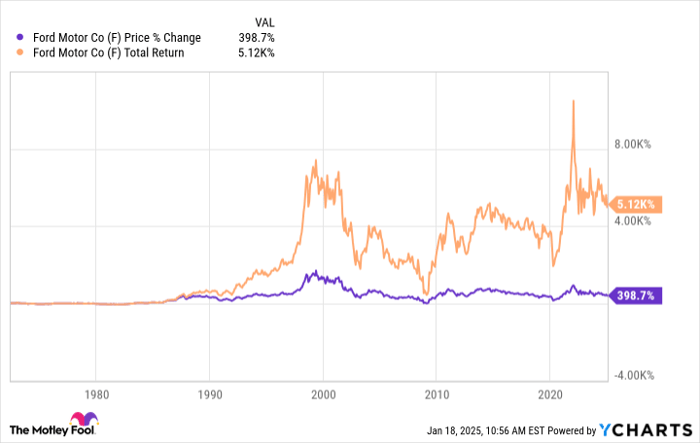Investors considering buying shares of Ford Motor Company (NYSE: F) have plenty to digest while developing their investment thesis. The company recorded a surge in warranty costs last year and will end up losing about $5 billion from its electric vehicle division in 2024. In addition, it has struggled to generate meaningful earnings overseas.
That said, for income investors, Ford's 6% dividend yield is enticing, but is it safe from being cut amid all of Ford's problems?
Start Your Mornings Smarter! Wake up with Breakfast news in your inbox every market day. Sign Up For Free »
Power of dividends
There are a number of reasons that Ford's dividend is appealing for investors. Not only is its 6% yield much higher than the S&P 500's (SNPINDEX: ^GSPC) average yield of 1.2%, the power of reinvesting dividends over time turns Ford into a wealth generator. Take a look at the difference between Ford's total return, which includes dividends, compared to just its stock price increase over the long haul.
In fact, Ford's dividend is the only way to generate wealth because the stock has declined 32% during the past 10 years.
Taking it a step further, what some investors forget about Ford's dividend is that the company often pays out supplemental dividends when it's generating extra cash flow or when it has substantial developments, such as selling its large stake in EV maker Rivian years ago. Management targets a consistent return of 40% to 50% of adjusted free cash flow (FCF) to investors.
But the question for investors remains: Is the dividend safe?
Part of the family?
In a way, investors buying Ford stock for dividend income are aligned with Ford family interests. Unbeknownst to many, the family owns special Class B shares, which represent a small portion of the equity, but give the family the right to elect 40% of the company's board. Essentially, the Ford family still effectively controls the company, and its shares also receive the same dividend that common shareholders do -- and the Ford family enjoys their dividend payouts.
Because the family has interests in lucrative and consistent dividends, while effectively controlling the company's direction, Ford is much less likely to cut the payout unless dire circumstances come up. This is also why Ford has yet to really dive into a large share repurchase program, because that would offer less income to the Ford family than using that cash for dividend payments.
Furthermore, despite Ford's woes with EV losses, struggles in China, and higher warranty costs, the company is still generating strong cash flow. Ford's adjusted FCF (what's left of cash flow after capital spending) through the first nine months of 2024 checked in at nearly $6 billion, and the company's strong balance sheet boasts cash of roughly $28 billion and total liquidity of about $46 billion. Ford is also pulling back on roughly $12 billion of projects and plans for EV development, lowering capital expenditures, which will boost free cash flow.
What it all means
Ford's dividend is essential to investors and the Ford family alike, and the company has emphasized its commitment to returning value to shareholders primarily through the dividend, rather than stock buybacks. Although the automotive industry is cyclical and may cause investors to question whether the dividend is safe amid a handful of costly issues in its global business, there shouldn't be many concerns absent some calamity such as a global pandemic or financial crisis.
Ford's dividend will remain a critical aspect of buying the stock, but investors also have to weigh the fact the stock price has remained stagnant for years, and that the company needs to turn around many aspects of its business for that price to climb.
Don’t miss this second chance at a potentially lucrative opportunity
Ever feel like you missed the boat in buying the most successful stocks? Then you’ll want to hear this.
On rare occasions, our expert team of analysts issues a “Double Down” stock recommendation for companies that they think are about to pop. If you’re worried you’ve already missed your chance to invest, now is the best time to buy before it’s too late. And the numbers speak for themselves:
- Nvidia: if you invested $1,000 when we doubled down in 2009, you’d have $357,084!*
- Apple: if you invested $1,000 when we doubled down in 2008, you’d have $43,554!*
- Netflix: if you invested $1,000 when we doubled down in 2004, you’d have $462,766!*
Right now, we’re issuing “Double Down” alerts for three incredible companies, and there may not be another chance like this anytime soon.
*Stock Advisor returns as of January 13, 2025
Daniel Miller has positions in Ford Motor Company. The Motley Fool has no position in any of the stocks mentioned. The Motley Fool has a disclosure policy.
The views and opinions expressed herein are the views and opinions of the author and do not necessarily reflect those of Nasdaq, Inc.



